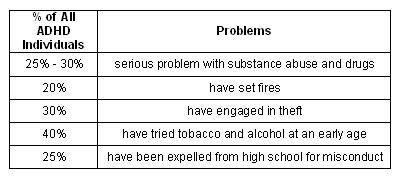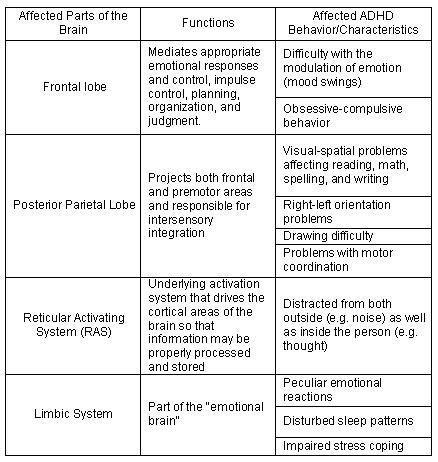Epidemiology & Etiology
How Many People Have ADHD?
Studies have shown that ADHD affects roughly 3-5% of all school-age children in the United States, 2-6.7% (est.) in New Zealand, 8.7% (est.) in Germany, 7.7% (est.) in Japan, and 8.9% (est.) in China.

Most reports also indicate a ratio of 4 boys to each girl affected. Females are often under-diagnosed among adults. Other statistical summaries of ADHD in the United States are shown and listed below:

:: The chance that other members of the family may also have ADHD if one of them has one is 25%.
:: Roughly 75-80% of all those with ADHD respond to stimulant medication.
:: Teens with ADHD are four times more likely to have serious auto accidents and three times more likely to be cited for speeding.
What Causes ADHD?
Possible Causes of ADHD
Although the exact cause of ADHD is still unknown, scientists have come up with probable theories about this in the past few decades. This section explicates all the possible causes of ADHD.
Genetic Evidence
Studies repeatedly demonstrate that the child of an adult with ADHD has approximately 25% chance of having ADHD. Flick presented the studies conducted by scientists and researchers regarding the genetic linkages of ADHD. These studies include children in families where there is history of ADHD, adopted children, and twins. They showed positive results.
However, there have been numerous criticisms and obvious limitations of these studies. Reliability of participants’ recollection, prenatal conditions of twins, and prenatal conditions of adopted children were put into question. With these studies, it was hard to generalize the findings to all ADHD patients.
Brain Physiology
Neuroanatomical Evidence
According to Dr. Flick, Mirky noted in 1987 that the brain has different but interconnected parts that are involved with the aspects of attention. This system of interrelated sections of the brain is engaged with focused, sustained, selective, alternating, and divided attention. Technological advancement in recent years expanded exploration on this matter.
Brain-imaging studies at the National Institute of Mental Health indicate a smaller anterior frontal area and a lack of asymmetry in parts of basal ganglia (caudate and globus pallidus). Further studies showed that this asymmetry in the basal ganglia is not affected by the use of stimulant medication.
Researches showed that for normal children, the right side of the caudate is 3% larger than the left on the average. ADHD individual failed to show this asymmetry. Reports also showed that the right prefrontal brain region was significantly smaller in ADHD boys compared with normal. The globus pallidus was also found to be significantly smaller, especially on the right side. Hyperactive children also have smaller total cerebral volume compared to normal children.
Neuropsychological Evidence
A series of tests that includes card sorting, IQ measurement, reading skills, and verbal memory were made to evaluate children who manifests ADHD as compared to normal. An assessment of their attention and impulsivity was also done. It has been found out that ADHD individuals have frontal lobe dysfunction of the brain. It was concluded that the core deficiency of ADHD is not impulsivity but the inability to control, direct, and sustain attention.
Neurochemical Evidence
Dr. Flick acknowledged that dopamine and norepinephrine neurotransmitters may be involved in ADHD. Relative overactivity of dopamine circuits is associated with hyperactivity and impulsivity symptoms of ADHD. However, it was noted that these review on the pharmacologic effects on neuronal circuits should not be interpreted as suggesting that ADHD is exclusively treatable with medication.
To sum up, the table below shows the affected brain functions and their effect on the behavior and characteristics of ADHD individuals.

Since ADHD is a complex disorder, these biological findings are still and certainly not complete. And it is still unclear if these dysfunctions are causes or symptoms of ADHD.
Unproven Causes
All kinds of speculation have been made regarding the cause of ADHD and the following are not yet proven nor did not show relatively significant findings.
Environmental Agents
Use of Cigarettes and Alcohol during Pregnancy
A lot of disorders and disabilities in children have been correlated with maternal use of cigarettes and alcohol during pregnancy. According to National Institute of Mental Health, studies have shown that this could be a possible risk.
Exposure to Lead
High level of lead in the bodies of young preschool children is another environmental agent that may be connected to a higher risk of ADHD. Children are exposed to toxic levels of lead through lead paints. Since lead is no longer allowed in paint, older buildings in which lead still exists in the plumbing or on the walls with lead paint put children at risk.
Food/Diet
Refined sugar or food additives were also suggested to cause or aggravate the symptoms of ADHD. According to the National Institute of Mental Health, in 1982 the National Institutes of Health found that diet restrictions helped about 5 % of children with ADHD, mostly young children who had food allergies.
However, a more recent study contradicts parental beliefs that sugar affects children’s hyperactivity. The research used sugar one day and sugar substitute on alternate days, without parents or staff or children knowing which substance was being used. This experiment showed no significant effects on the behavior or learning of ADHD children.
Poor Parenting
Some concluded that poor parenting is a cause of children’s uncontrolled behavior. This conclusion is not applicable to all cases and has not generated any significant findings to support its claim.
Studies have shown that ADHD affects roughly 3-5% of all school-age children in the United States, 2-6.7% (est.) in New Zealand, 8.7% (est.) in Germany, 7.7% (est.) in Japan, and 8.9% (est.) in China.

Most reports also indicate a ratio of 4 boys to each girl affected. Females are often under-diagnosed among adults. Other statistical summaries of ADHD in the United States are shown and listed below:

:: The chance that other members of the family may also have ADHD if one of them has one is 25%.
:: Roughly 75-80% of all those with ADHD respond to stimulant medication.
:: Teens with ADHD are four times more likely to have serious auto accidents and three times more likely to be cited for speeding.
What Causes ADHD?
Possible Causes of ADHD
Although the exact cause of ADHD is still unknown, scientists have come up with probable theories about this in the past few decades. This section explicates all the possible causes of ADHD.
Genetic Evidence
Studies repeatedly demonstrate that the child of an adult with ADHD has approximately 25% chance of having ADHD. Flick presented the studies conducted by scientists and researchers regarding the genetic linkages of ADHD. These studies include children in families where there is history of ADHD, adopted children, and twins. They showed positive results.
However, there have been numerous criticisms and obvious limitations of these studies. Reliability of participants’ recollection, prenatal conditions of twins, and prenatal conditions of adopted children were put into question. With these studies, it was hard to generalize the findings to all ADHD patients.
Brain Physiology
Neuroanatomical Evidence
According to Dr. Flick, Mirky noted in 1987 that the brain has different but interconnected parts that are involved with the aspects of attention. This system of interrelated sections of the brain is engaged with focused, sustained, selective, alternating, and divided attention. Technological advancement in recent years expanded exploration on this matter.
Brain-imaging studies at the National Institute of Mental Health indicate a smaller anterior frontal area and a lack of asymmetry in parts of basal ganglia (caudate and globus pallidus). Further studies showed that this asymmetry in the basal ganglia is not affected by the use of stimulant medication.
Researches showed that for normal children, the right side of the caudate is 3% larger than the left on the average. ADHD individual failed to show this asymmetry. Reports also showed that the right prefrontal brain region was significantly smaller in ADHD boys compared with normal. The globus pallidus was also found to be significantly smaller, especially on the right side. Hyperactive children also have smaller total cerebral volume compared to normal children.
Neuropsychological Evidence
A series of tests that includes card sorting, IQ measurement, reading skills, and verbal memory were made to evaluate children who manifests ADHD as compared to normal. An assessment of their attention and impulsivity was also done. It has been found out that ADHD individuals have frontal lobe dysfunction of the brain. It was concluded that the core deficiency of ADHD is not impulsivity but the inability to control, direct, and sustain attention.
Neurochemical Evidence
Dr. Flick acknowledged that dopamine and norepinephrine neurotransmitters may be involved in ADHD. Relative overactivity of dopamine circuits is associated with hyperactivity and impulsivity symptoms of ADHD. However, it was noted that these review on the pharmacologic effects on neuronal circuits should not be interpreted as suggesting that ADHD is exclusively treatable with medication.
To sum up, the table below shows the affected brain functions and their effect on the behavior and characteristics of ADHD individuals.

Since ADHD is a complex disorder, these biological findings are still and certainly not complete. And it is still unclear if these dysfunctions are causes or symptoms of ADHD.
Unproven Causes
All kinds of speculation have been made regarding the cause of ADHD and the following are not yet proven nor did not show relatively significant findings.
Environmental Agents
Use of Cigarettes and Alcohol during Pregnancy
A lot of disorders and disabilities in children have been correlated with maternal use of cigarettes and alcohol during pregnancy. According to National Institute of Mental Health, studies have shown that this could be a possible risk.
Exposure to Lead
High level of lead in the bodies of young preschool children is another environmental agent that may be connected to a higher risk of ADHD. Children are exposed to toxic levels of lead through lead paints. Since lead is no longer allowed in paint, older buildings in which lead still exists in the plumbing or on the walls with lead paint put children at risk.
Food/Diet
Refined sugar or food additives were also suggested to cause or aggravate the symptoms of ADHD. According to the National Institute of Mental Health, in 1982 the National Institutes of Health found that diet restrictions helped about 5 % of children with ADHD, mostly young children who had food allergies.
However, a more recent study contradicts parental beliefs that sugar affects children’s hyperactivity. The research used sugar one day and sugar substitute on alternate days, without parents or staff or children knowing which substance was being used. This experiment showed no significant effects on the behavior or learning of ADHD children.
Poor Parenting
Some concluded that poor parenting is a cause of children’s uncontrolled behavior. This conclusion is not applicable to all cases and has not generated any significant findings to support its claim.


<< Home